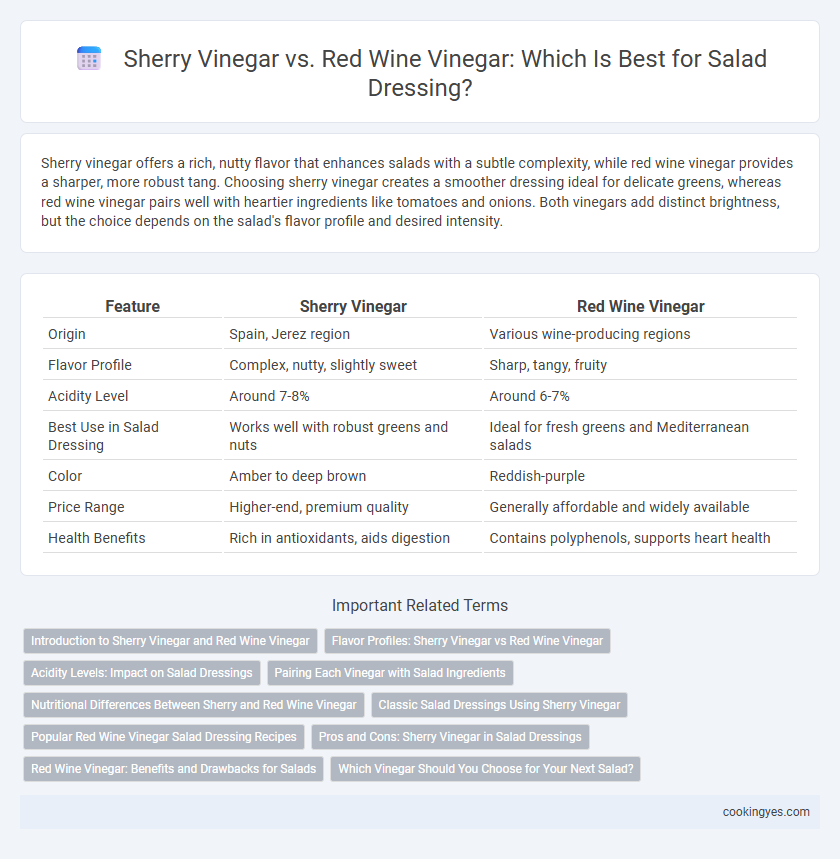Sherry vinegar offers a rich, nutty flavor that enhances salads with a subtle complexity, while red wine vinegar provides a sharper, more robust tang. Choosing sherry vinegar creates a smoother dressing ideal for delicate greens, whereas red wine vinegar pairs well with heartier ingredients like tomatoes and onions. Both vinegars add distinct brightness, but the choice depends on the salad's flavor profile and desired intensity.
Table of Comparison
| Feature | Sherry Vinegar | Red Wine Vinegar |
|---|---|---|
| Origin | Spain, Jerez region | Various wine-producing regions |
| Flavor Profile | Complex, nutty, slightly sweet | Sharp, tangy, fruity |
| Acidity Level | Around 7-8% | Around 6-7% |
| Best Use in Salad Dressing | Works well with robust greens and nuts | Ideal for fresh greens and Mediterranean salads |
| Color | Amber to deep brown | Reddish-purple |
| Price Range | Higher-end, premium quality | Generally affordable and widely available |
| Health Benefits | Rich in antioxidants, aids digestion | Contains polyphenols, supports heart health |
Introduction to Sherry Vinegar and Red Wine Vinegar
Sherry vinegar, made from fermented sherry wine, offers a complex, slightly sweet flavor with nutty undertones ideal for enhancing salad dressings. Red wine vinegar, derived from red wine fermentation, provides a sharp, tangy acidity that brightens fresh greens and balances rich ingredients. Both vinegars are essential pantry staples, each contributing unique depth and character to salad dressings based on their distinct production methods and flavor profiles.
Flavor Profiles: Sherry Vinegar vs Red Wine Vinegar
Sherry vinegar offers a complex, nutty flavor with subtle sweetness and a hint of acidity, enhancing salads with a rich, layered taste. Red wine vinegar provides a sharper, more robust acidity and fruity undertones, creating a vibrant and tangy dressing. Choosing between them depends on whether a salad dressing requires depth and warmth from sherry vinegar or bright, punchy notes from red wine vinegar.
Acidity Levels: Impact on Salad Dressings
Sherry vinegar typically has a higher acidity level of around 7-8%, offering a sharper and more intense flavor to salad dressings compared to red wine vinegar, which usually ranges from 5-7% acidity. The elevated acidity in sherry vinegar enhances the brightness and balance of robust greens, while red wine vinegar provides a milder, fruitier tang, preserving delicate flavors in leafy salads. Selecting the right vinegar acidity affects the emulsification process and overall harmony of oil and vinegar blends in salad dressings.
Pairing Each Vinegar with Salad Ingredients
Sherry vinegar's nutty, slightly sweet flavor enhances salads with robust ingredients like roasted vegetables, nuts, and aged cheeses, adding depth and complexity. Red wine vinegar's sharp, tangy profile pairs well with fresh greens, tomatoes, cucumbers, and herbs, brightening light, crisp salads. Choosing the right vinegar depends on the salad's ingredient intensity, balancing acidity and flavor to complement each component perfectly.
Nutritional Differences Between Sherry and Red Wine Vinegar
Sherry vinegar contains slightly higher antioxidant levels compared to red wine vinegar due to its aging process, enhancing its ability to neutralize free radicals in the body. Red wine vinegar offers a modest amount of resveratrol, a polyphenol linked to heart health, though its content is generally lower than that found in red wine itself. Both vinegars are low in calories and sodium, making them nutritious choices for salad dressings without significantly impacting dietary restrictions.
Classic Salad Dressings Using Sherry Vinegar
Sherry vinegar, renowned for its rich, nutty flavor and moderate acidity, elevates classic salad dressings by adding depth and complexity compared to the sharper bite of red wine vinegar. Traditional vinaigrettes using sherry vinegar pair exceptionally well with mixed greens, root vegetables, and vinaigrettes featuring Dijon mustard and olive oil. Its unique profile enhances dressings, offering a balanced tanginess that complements hearty ingredients in salads without overpowering fresh flavors.
Popular Red Wine Vinegar Salad Dressing Recipes
Red wine vinegar is a staple in popular salad dressing recipes, prized for its bold, fruity flavor and vibrant acidity that enhances mixed greens and Mediterranean-style salads. Unlike Sherry vinegar, which offers a sweeter, nutty profile, red wine vinegar pairs seamlessly with olive oil, garlic, and herbs, making it ideal for classic vinaigrettes like Italian or Greek dressings. Its versatility and robust taste contribute to its widespread use in recipes featuring ingredients such as tomatoes, cucumbers, and feta cheese.
Pros and Cons: Sherry Vinegar in Salad Dressings
Sherry vinegar offers a rich, nutty flavor with subtle sweetness that enhances salad dressings, making greens taste more complex and balanced. Its aged character adds depth without overpowering other ingredients, but its distinct taste can be too strong for delicate salads. Slightly less acidic than red wine vinegar, it complements robust greens yet might limit versatility compared to the more neutral and tangy profile of red wine vinegar.
Red Wine Vinegar: Benefits and Drawbacks for Salads
Red wine vinegar enhances salad dressings with its robust, tangy flavor that complements a variety of greens and vegetables, providing antioxidants and probiotics for digestive health. It also contains acetic acid, which may aid in blood sugar regulation and weight management. However, its strong acidity can overpower delicate salad ingredients and may cause irritation for individuals with sensitive stomachs.
Which Vinegar Should You Choose for Your Next Salad?
Sherry vinegar offers a rich, nutty flavor ideal for robust salad dressings, enhancing ingredients like arugula and roasted vegetables with subtle complexity. Red wine vinegar provides a sharper, more acidic taste that brightens fresh greens and tomatoes, perfect for classic vinaigrettes. Choosing between sherry and red wine vinegar depends on whether you prefer a mellow depth or a vibrant tang in your salad.
Sherry vinegar vs Red wine vinegar for salad dressing Infographic

 cookingyes.com
cookingyes.com